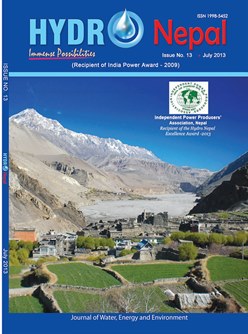Optimized Design of Francis Turbine Runner for Sand Laden Water
DOI:
https://doi.org/10.3126/hn.v13i0.10038Keywords:
Francis runner, Optimization, CFD (Computational Fluid Dynamics), FSIAbstract
Nepal has an enormous amount of water resources and the topography gives rise to a huge hydropower potential. Out of 83,000 MW, only about 43,000 MW is economically and technically feasible. However, rivers of Nepal contain heavy quantities of sand particles. This is why the hydropower plants of this region face severe sand erosion problem.
Erosion mechanism in hydropower is a complex phenomenon. It is a major technological challenge for R-O-R (Run off river) hydropower plants. There are several technologies to reduce erosion but none of them has proven to be economically viable. The hydraulic design of the turbine with a new design philosophy expected to reduce sand erosion considerably and this process is economic too.
This paper describes the alternative optimized design of Francis turbine runner for large sediment load. The process involves optimization to obtain specific Francis runner blade using not defined ANSYS CFX parametric study. The process also includes analysis of the runner blade using CFX parametric study and Fluid structure interaction simulation for specific blade design. Design and drafting of the runner and part model design for FSI (Fluid Structure Interaction) analysis have also been described.
DOI: http://dx.doi.org/10.3126/hn.v13i0.10038
HYDRO NEPAL Journal of Water, Energy and Environment
Issue No. 13, July 2013
Page: 36-43
Uploaded date: 3/13/2014
Downloads
Downloads
Published
How to Cite
Issue
Section
License
The copyright of the articles and papers published is held by HYDRO Nepal Journal.
The views and interpretation in this journal are those of author(s), and HYDRO Nepal does not bear any responsibility for the views expressed by authors in the journal.




